
40m Buzz Saw - aa5tb_039.mp3 recording
The "Buzz Saw", sometimes known as the "Saw Mill" sounds just like the name implies. It has been reported on the bottom ends of the 40m and 80m ham bands and sometimes in the aeronautical bands just below 80m. When I first heard the reports from other amateurs I suspected it was just the RFI (Radio Frequency Interference) from local computer monitors since no one could verify that it was a sky wave signal. Well, on October 13, 1999 I happened to be listening on 7040 kHz when it came up on the air at about 0318 UTC. The transmissions would jump frequencies every few minutes but not at regular intervals. I measured the different transmission center frequencies at about 7020 kHz, 7040 kHz, 7050 kHz, 7070 kHz, 7080 kHz, and 7090 kHz. I never heard the transmission at any more then one of these frequencies at a time. The signal strengths were always identical indicating the individual transmissions were probably all coming from the same transmitter. Sky wave fading characteristics were evident and local source possibilities were eliminated.
I made several digital recordings on the transmissions and performed some spectrum analysis on the signal. The transmission appears to be less then 3 kHz wide and consist of many sidebands that are equally spaced. It may be a frequency modulated signal with the modulation index such that the carrier is nulled out. I could detect no intelligence being transmitted although some low frequency analog modulation (frequency selective flutter) was apparent in the individual sidebands. This modulation was probably caused naturally by auroral flutter. Many other signals on 40 meters at that time had the flutter on them.
It is interesting to note that the transmission on a given frequency would stop within tenths of a second when a strong CW station would come on the air. This may have just been coincidence.
There are many possibilities of what this transmission could be for. A possibility could be a new over-the-horizon radar, such as a HFSWR (High Frequency Surface Wave Radar) or maybe a jammer. The bandwidth is pretty narrow though for such a radar. I don't know why a jammer would be used at such a frequency unless undetectable communications were taking place in some distant part of the world that we can't hear but that someone thinks needs to be jammed.
UPDATE - The ARRL announced on January 11, 2001 that the source of this interference was from Iranian jammers jamming Iraqi pirate transmitters. See the following ARRL News Story.

